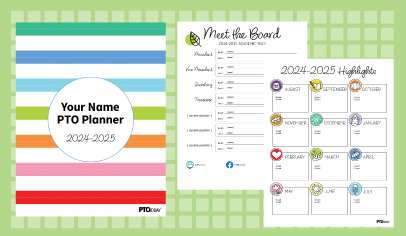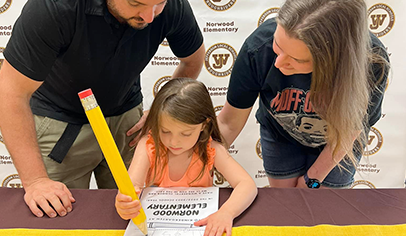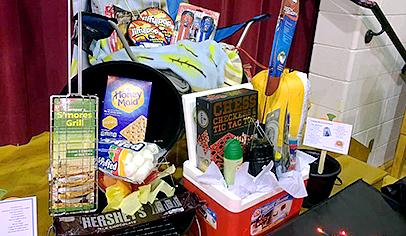Every communication from your parent group sends a message to parents about involvement—even if that’s not your intention. If your messages are positive, cheerful, courteous, appreciative, simple, direct, and customer-service-oriented, then you’re telling parents that the PTO will appreciate their efforts and that their time with the group will be enjoyable.
On the other hand, if your messages are negative, demanding, scolding, and overly complicated, then you’re turning away parents, who’ll view your group as unfriendly, unappreciative, and difficult to work with.
Every written and oral communication has the potential to encourage or discourage participation in the PTO. So it pays to think about the involvement message you’re sending.
Ask People Directly
First, make sure parents know that you really want them to get involved. “Too many parent groups make the assumption that if parents want to get involved, they will get involved, and so the group doesn’t necessarily ask them,” says Kati Hanna, copresident of the Parent Advisory Council at Sierra Vista Primary School in Ruidoso, N.M. The PAC sends out a monthly newsletter that includes calls for specific volunteers, along with a contact person. For example, a request for volunteers for Popcorn Days stresses that no experience is needed, that someone will train the volunteer, that parents can assist as it fits their schedules, and that “any help would be extremely appreciated.”
More parents became involved as the PAC issued more specific invitations. “We wouldn’t have been able to remotely get our volunteer base if we didn’t communicate and ask,” Hanna says. “There were parents who, there was no doubt in my mind, would have never entered our school, but we made it so easy that they got involved.”
Reduce the Pressure
Take any steps you can to make it easier for parents to volunteer. Pike Creek Christian School in Newark, Del., has a huge volunteer board in its school lobby. “People pass it and don’t feel any pressure,” says Parent Teacher Fellowship copresident Kristal Courter. “It’s there throughout the year. They can think about it if they want to sign up at the first of the year. If they change their mind, the next day they can take their name off. We talk about the board at all events and remind them about it in most of our communications.”
Open the Lines of Communication
However you communicate with parents, be consistent. Send newsletters or emails on a regular schedule so that parents are expecting the contact. In these communications, emphasize what the parent group does for the school. Sierra Vista uses its website to inform parents about when and how the group is meeting its goals. In its newsletter, Forest Park Elementary in Little Rock, Ark., explains some of the smaller things the PTA does, such as paying for an off-duty police officer to assist with traffic on the first three days of school.
Make your PTO leaders more accessible to parents. On your website, in handouts, in newsletters, and on a bulletin board at school, include a photo of each officer and chairperson, along with emails and phone numbers.
Recognize Volunteers
It doesn’t hurt to offer perks to potential volunteers. At Sierra Vista, volunteers who work one hour get a free school T-shirt. They can also place free classified ads in the parent group newsletter, in which parents advertise services or items for sale.
Put effort into recognizing volunteers. Sierra Vista features a “parent volunteer of the month” article and photo in its monthly newsletter. Lamar Middle School in Austin, Texas, thanks individual volunteers in its newsletter after an event. “That’s a critical thing,” says PTA president Michelle Smith. “If you say thank-you to parents, that’s all they really want. We keep a list of who’s done what and try to thank every volunteer.” At South Mountain Elementary in Edgewood, N.M., where the school mascot is a coyote, parents who volunteer at least two hours with the PTO get their name on a paw print posted on a big board in the lobby entryway.
Show the Fun Side
One of the most overlooked aspects of communicating a positive involvement message has to do with showing that participating in PTO events can be fun. Sierra Vista creates poster boards with photos of volunteers at previous events. These boards are displayed in the lobby and are propped behind the parent group table at special events. “We show that it’s fun and that it’s a united group” of diverse individuals, Hanna says. “They may think the parent group is run by a specific group, but we show that everybody is welcome.”
The PTA for Chesak and Martin elementary schools in Lake in the Hills, Ill., posts photos online for a similar purpose. “One of our messages is that we’re not the PTA your parents used to know,” says president Dana Wiley. “We show parents helping out at the local pool, or at an open house talking to people or helping to carry boxes. These photos take away the preconceived notion that the PTA is a lot of work and that there’s not a lot of fun involved. And it changes the notion of the type of person who gets involved.”
Go Digital
Many parent groups take advantange of tech tools to promote involvement. At Sierra Vista, parents can sign up to get an email notification when items are added to the PAC website, and the parent group also uses an automated phone-calling system to remind parents about upcoming events. “We say we look forward to every parent coming, and it’s made a big difference,” Hanna says.
Forest Park Elementary has used anonymous online surveys to get feedback from parents. “We’re making a big push this year to make sure people feel the PTA can work for them,” says PTA president Cindy Pugh. “We asked what they valued in terms of things we do and where to spend the money we raised, and we have made some changes according to the survey results.”
Forest Park also emails event invitations to parents, who can click on a link to register for the event. This registration information is then sent in list form to the parent group. “It will serve us to connect with busy parents who feel we are keeping them informed in a way that works for them,” Pugh says. “Also, it is streamlining our volunteer efforts from processing PTA papers and orders to focusing on events, activities, and students.” (Remember that not everyone has easy online access, so keep paper as an option for those who need or want it.)
Get Personal
Don’t overlook opportunities for personal conversations. At Greenwood Elementary in Seattle, a good resource is the school’s social worker, who passes on flyers and reminds parents she works with about upcoming events. Other opportunities present themselves on the playground as parents drop off or pick up their children. “People sometimes have the connotation of the PTA being a clique or full of overbearing parents,” says PTA copresident Deb Fitzpatrick. “And it’s funny. Out on the playground, I’ll be talking to a parent and another parent will walk up to me and say, ‘Hi, Prez,’ and then the first parent will ask what that was about and I’ll say I’m the PTA copresident. Then that first parent will say, ‘I didn’t think it was like that.’ ”
Cheat Sheet: Keys for Communication
Invite parents to get involved. Make sure they know they’re welcome at all PTO activities.
Make it easy to volunteer. Use a bulletin board and electronic links where parents can sign up. And be sure to include photos and contact information for all officers and chairpersons on your website.
Show volunteers you value them. Being appreciative is key. Offering a perk like a free T-shirt can be a nice touch.
Communicate regularly. Send newsletters or emails on a regular schedule so parents expect to hear from you.
Tout PTO accomplishments so parents know how the group’s efforts are benefiting the school.
Recognize volunteers. Include the name and photo of each person, along with their accomplishments, on a bulletin board or in your newsletter.
Display photos of volunteers and participants to show that the PTO is fun and inclusive.
Use technology to involve parents. If parents at your school are online, you should be, too. Keep paper copies of your communications available for those who want or need them.
Translate PTO communications for non-English-speaking parents so that they’re included.
Use person-to-person contact. Recruit school social workers and others to pass on flyers and other sources of information to parents who might not be reachable through regular channels. And never miss an opportunity to engage parents, especially those who might view the PTO as a clique.
Originally posted in 2009 and updated regularly.

























